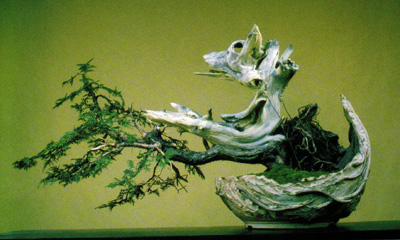
You like unconventional? Crazy? How about daring and masterful? Notice how the color and design of the pot plays with the wild shari (deadwood) and the small touch of moss on the left mirrors the foliage. Just another bonsai from left field by crafty old Nick Lenz, master left fielder, author, and preeminent (whatever that means) master of cedars, larches and other collected North American gems. This photo is from North American Bonsai (American Bonsai Society – compiled and edited by Martin Schmalenberg), now on sale at Stone Lantern.
When is a cedar not really a cedar?
The tree featured here is commonly called a Northern (or Eastern) white cedar, when in fact it’s actually a variety of arborvitae (botanical name; Thuja occidentalis). Lots of trees that aren’t cedars are called cedar, including at least one juniper (Eastern red cedar; Juniperus virginiana), one false cypress (Atlantic white cedar; Chamaecyparis thyoides), the California Incense cedar (Calocedrus decurrens), Japanese cedar (Cryptomeria japonica) and no doubt others. What most of these share is fan shaped foliage (like Nick’s tree above). Interestingly, true cedars (Cedrus) don’t have fan shaped foliage. Confused? You’re not alone.
When is a cedar a really cedar?
There are a handful of true cedars (Cedrus) in the world, the best known of which are: the Deodar cedar (C. deodara) from the Himalayas, and two from the Mediterranean: the Lebanon cedar (C. libani) and the Atlas cedar (C, atlantica).

An earlier (less professional) photo of the same tree. You can find this one in Nick’s excellent book on collecting bonsai, Bonsai from the Wild (Stone Lantern Publishing).